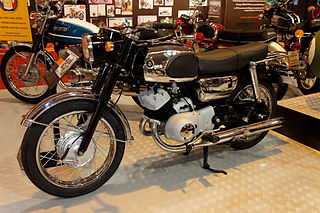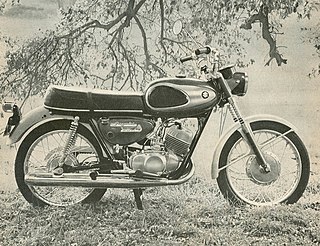The Honda XR series is a range of four-stroke off-road motorcycles that were designed in Japan but assembled all over the world.

The Suzuki RG150 was a 148 cc two-stroke racing motorcycle produced by Suzuki in Thailand. The bike was produced from 1996 until 2000. In 1998, it was selected as the second-best new motorcycle of 1998 by Motor Trend magazine.

The Suzuki RGV250 was a Suzuki high performance sport bike which had a great number of its features and design cues based on Grand Prix technologies and ideas. It is a race-replica based on Suzuki's 250 cc (15 cu in) GP bikes from 1987 to 1998, the RGV V-2 racer. This motorcycle replaced the RG250 Gamma, which employed an alloy frame with a two-stroke parallel twin engine. The bike produced over 60 bhp in a narrow power band between 8,000 and 11,000 rpm. The dry weight ranged between 128 kg (282 lb) (1989) to 140 kg (309 lb) dry weight.
The Honda CT series was a group of Honda trail bike motorcycles made since 1964. The CT designation is a slight exception in Honda nomenclature in that "CT" does not indicate a series of mechanically related bikes, but rather a group of different bikes that are all for casual off-road use.

The Suzuki T series was a series of motorcycle manufactured by Suzuki that ran from approximately 1963 through 1977 in various engine displacements between 90 and 500 cc.

The Suzuki TU250— marketed also as the TU250X, ST250 and ST250 E-Type — is a single-cylinder, air-cooled lightweight street bike manufactured by Suzuki across two generations from 1994-2019.

The BSA C15 was a 250 cc single-cylinder ohv motorcycle manufactured by the British company BSA from September 1958 until 1967, and was BSA's first four-stroke unit-construction bike. For most of that period, after the introduction of 'Learner Laws' in 1961, a 250 cc was the largest capacity solo machine that a learner could ride unaccompanied when displaying L-plates in the United Kingdom. A road-going Sports derivative was added in 1961, and off-road versions, for Trials and Scrambles, were also available in the range.

The Honda SS50 is a 50 cc (3.1 cu in) motorcycle manufactured by the Honda Motor Company.

Magni is an Italian company that builds specialist motorcycles. The company is based in the city of Samarate in the province of Varese. Magni, in addition to building the bikes that bear its name, is also active in the construction of specials to order and a supplier of special parts for the restoration of MV Agusta classic motorcycles.
The MV Agusta 250B (Bicilindrica) was a motorcycle produced by the Italian manufacturer MV Agusta from 1968 to 1971. The motorcycle was first introduced at the 1965 Milan EICMA motorcycle show and was based on the stillborn MV 166 Arno GT. The model was discontinued in 1971 following the introduction of an overbored version, the 350B.

Bridgestone motorcycles were a division of the Bridgestone Tire Co. of Kyōbashi, Tokyo, Japan that produced mopeds and motorcycles from 1952 to 1970. Initially producing power assisted bicycles, the division moved on to producing mopeds and then motorcycles. The motorcycles were technologically advanced and powered by two-stroke engines. The high technical specification resulted in the machines being more expensive compared to other manufacturers models. Production was stopped in 1970 to protect the supply of tyres to other manufacturers.

The Suzuki T10 is a 246 cc (15.0 cu in), two-stroke, twin-cylinder motorcycle produced by the Japanese Suzuki company between 1962 and 1967. The model was based on the earlier Colleda TT and had an improved frame. It was marketed as the El Camino in the US and was Suzuki's first twin the be sold in America.

The Suzuki T250, also known as the Suzuki Hustler is a 247 cc (15.1 cu in), two-stroke, twin-cylinder motorcycle produced by the Japanese Suzuki company between 1969 and 1972. The model was developed from the earlier T20 and was one of the models that contributed to Suzuki's success in the early 1970s.
The Suzuki T90, also known as the Suzuki Wolf is a 89 cc (5.4 cu in), two-stroke, twin-cylinder motorcycle produced by the Japanese Suzuki company between 1969 and 1972.The T90 was radically styled and except for the engine size, the model was the same as the Suzuki T125.

The Suzuki T200, also known as the Suzuki Invader and the X5 in the US is a 196 cc (12.0 cu in), two-stroke, twin-cylinder motorcycle produced by the Japanese Suzuki company between 1967 and 1971. The model was a scaled down version of the Suzuki T20.

The Suzuki T500, variously known as the Suzuki T500/Five, Suzuki Charger, Suzuki Cobra and the Suzuki Titan during its model life, is a 492 cc (30.0 cu in), two-stroke, twin-cylinder motorcycle produced by the Japanese Suzuki company between 1968 and 1975. The model was developed as a larger version of the Suzuki T20 which was intended to compete with the large-capacity British twins in the American market. When introduced it was Suzuki's largest displacement machine. Overengineering of the engine led to the bike gaining a reputation for reliability, and being virtually bulletproof. A total of over 100,000 units were sold during the model's production.

The Ducati 125 Scrambler is an on/off road 124 cc (7.6 cu in) single cylinder bevel drive SOHC motorcycle produced by the Italian manufacturer Ducati in 1971 and 1972. Although Ducati had stopped production of the 'narrow case' singles in 1967, the Scrambler used a narrow case engine made by MotoTrans in Spain. The model was not a sales success with less than 200 sold worldwide and was soon taken out of production.

The Ducati 250 Scrambler, known in Europe as the Ducati 250 SCR is an on/off road 249 cc (15.2 cu in) single cylinder bevel drive SOHC motorcycle produced by the Italian manufacturer Ducati from 1962 to 1974. Originally produced for the American Market at the request of the US importers, Berliner Motor Corporation, the model was offered in Europe from 1968. Total production was around 12,000 machines.
The Ducati Strada is a 249 cc (15.2 cu in) single cylinder bevel drive SOHC motorcycle produced by the Spanish manufacturer MotoTrans, who were licensed by Ducati to produce motorcycles under the Ducati brand name and was produced from 1978 to 1983. The model is based on the 250 'wide case' Ducati singles which the Italian Ducati factory had stopped manufacturing in 1974, but which MotoTrans continued to develop and produce.

The Ducati Forza is a 340 cc (21 cu in) single cylinder bevel drive SOHC motorcycle produced by the Spanish manufacturer MotoTrans, who were licensed by Ducati to produce motorcycles under the Ducati brand name and was produced from 1976 to 1983. The model is based on the 350 'wide case' Ducati singles which the Italian Ducati factory had stopped manufacturing in 1974, but which MotoTrans continued to develop and produce.















